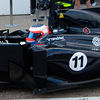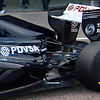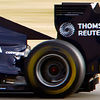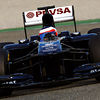Williams FW33 Cosworth
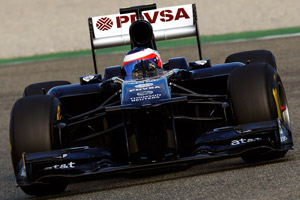
Active: 2011
Team: Williams F1
Team: Patrick Head (Director of Engineering), Alex Burns (CEO), Frank Williams (TP), Ed Wood (CD), Jon Tomlinson (HA), Sam Michael (TD)
Drivers: Rubens Barrichello (11), Pastor Maldonado (12), Valtteri Bottas (test)
Williams have put an enormous amount of work into their FW33 as they were fed up with being a midfield contender. Aerodynamic work started in December 2009, with the mechanical aspects of the FW33 beginning in March 2010. The major layout decisions were finalised in June, following the World Motorsport Council’s confirmation of the 2011 rule changes.
Technical analysis
Because of the effort put into the car, it is quite different from its predecessor, the Williams FW32. First this to take into account were the changed diffuser regulations, which made it ever more important to have a clean rear end of the car that would allow plenty of airflow onto the rear wing, the beam wing and over the diffuser. It is especially in this area where the Williams is different from its rivals.
At first sight this car might look as unfinished at the rear due to its compactness and lack of bodywork between the rear wheels. To accomplish this, Williams have designed a completely new seven-speed gearbox, the smallest ever produced by the team. It is an extremely low design to clean airflow above it. Because of its low position, the rear suspension is also very particular, as the rear upper wishbones connect to the central rear wing support, while the front ones connect to the engine. The pull rod still connects to the gearbox, just above the car's floor. A push rod was simply out of the question when designing such a low rear end.
Williams technical director, Sam Michael, noted: “With gearbox usage increasing from four to five races this year, reliability is vital. But I’m not expecting it to be a problem because the new gearbox has the same stiffness characteristics as the old one and the rulebook forces us to be conservative with the internals. For the last few seasons the ratios have to be 12mm wide and 600g per pair, whereas in the past we were down to 8-9mm gears.”
Particularly as the double diffuser was banned, it was important to get the rear end developed well in order to try to regain some of the lost downforce: "Not only can you not open any holes between the reference and step planes, you must have continuous material through all lateral and longitudinal sections. The scope for developing anything on the diffuser is limited, so we’re looking at the centre, rear and front of the floor, as well as the sides of the floor and the little area around the tyre spat, all of which are still free."
"The ban on double diffusers should tighten up the field. It will probably happen straight away, but even if it doesn’t and someone comes to the first or second test with something you hadn’t thought of elsewhere on the car, it’ll be easy to replicate it and get it onto the car quickly because it shouldn’t affect the underlying car structure such as the gearbox.”
More towards the front, Williams have followed the trend to increase the height and width of the nose to feed more air into the floor of the car. Under the nose are now two turning vanes, alike on the Red Bull RB6 during the second half of 2010.
Apart from the aerodynamic changes, Williams have also built in the KERS system as that is permitted again in 2011. The team however chose for a battery system in favour of its own flywheel device.
"Williams Hybrid Power (WHP) is developing a flywheel KERS for use in industry. The system was tested in an F1 car in ’09, but the current regulations favour the use of the battery system, which Williams F1 assembles and builds in-house."
"The rules have changed since KERS was last used in F1. Re-fuelling is no longer permitted, so the packaging is different now. We have packaged our KERS system entirely inside the car’s survival cell, below the fuel tank, because we didn’t want to compromise any of the sidepod area for aerodynamics. The car is longer than last year as a result, but the advantages of doing that outweigh the negatives. Assuming you’re on the weight limit, there is no downside to KERS; it’s worth 0.3s and it gives you a better start."
Williams have also built in a movable rear wing, a possibility introduced in the 2011 regulations. When trailing another car, the driver can active a hydraulic actuator which will lift the upper rear wing element at the front until the slot gap is 50mm.
Finally, the car's design process also had to be changed slightly as the new Pirelli tyres had to be taken into account. The dimensions of the tyres are the same as in 2010, but the performance characteristics are very different, as Williams F1 discovered during a two-day evaluation of the tyres in Abu Dhabi last November. “The Abu Dhabi test was quite useful. There is a change to the aerodynamics; lots of little details make a difference to the wake of the tyre and we learnt a lot about that in Abu Dhabi. The Pirelli rubber deflects and deforms in a different way to that of Bridgestone and it has different mould lines, all of which can affect the tyre wake. “Overall, though, the arrival of Pirelli is not an intimidating change. We didn’t change a lot on the mechanical side of the new car after the Abu Dhabi test; the main changes we’ve made since then have been aero.”
Specifications
Chassis construction: Monocoque construction fabricated from carbon epoxy and honeycomb composite structure, surpassing FIA impact and strength requirements
Front suspension: Carbon fibre double wishbone arrangement, with composite toelink and pushrod activated springs and anti-roll bar
Rear suspension: Double wishbone and pullrod activated springs and anti-roll bar
Transmission: Williams F1 seven speed seamless sequential semi-automatic shift plus reverse gear.
Gear selection: electro-hydraulically actuated
Clutch: Carbon multi-plate
Dampers: Williams F1
Wheels: RAYS forged magnesium
Tyres: Pirelli, Fronts: 325mm wide, Rears: 375mm wide
Brake: system 6 piston callipers all round, carbon discs and pads
Steering: Williams F1 power assisted rack and pinion
Fuel system: Kevlar-reinforced rubber bladder
Electronic systems: FIA standard electronic control unit
Cooling system: Aluminium oil, water, and gearbox radiators
Cockpit: Driver six point safety harness with 75mm shoulder straps & HANS system, removable anatomically formed carbon fibre seat covered in Alcantara
Dimensions & weight
Weight: 640kg with driver, camera and ballast
Wheelbase: 3300mm
Overall length: 5000mm
Overall height: 950mm
Overall width: 1800mm
Engine
Designation: Cosworth 2.4L V8, 90° V angle engine, pneumatic valve train.
Fuel management and ignition systems: Cosworth.
Materials: Block and pistons in aluminium, crankshaft in steel billet, connecting rods in titanium

